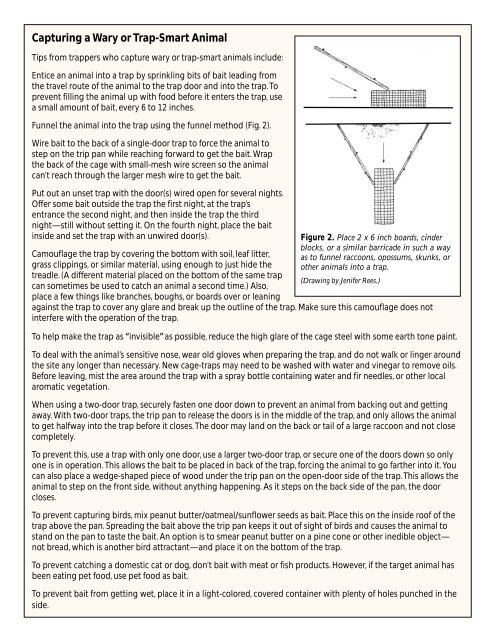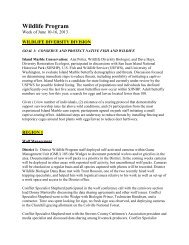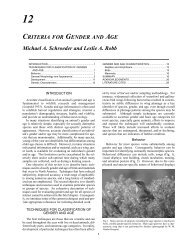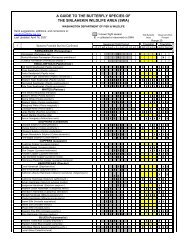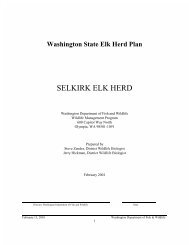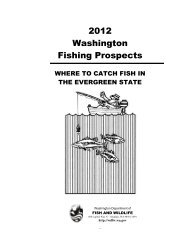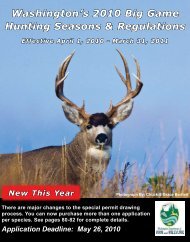Trapping Wildlife - Washington Department of Fish & Wildlife
Trapping Wildlife - Washington Department of Fish & Wildlife
Trapping Wildlife - Washington Department of Fish & Wildlife
Create successful ePaper yourself
Turn your PDF publications into a flip-book with our unique Google optimized e-Paper software.
Capturing a Wary or Trap-Smart Animal<br />
Tips from trappers who capture wary or trap-smart animals include:<br />
Entice an animal into a trap by sprinkling bits <strong>of</strong> bait leading from<br />
the travel route <strong>of</strong> the animal to the trap door and into the trap. To<br />
prevent filling the animal up with food before it enters the trap, use<br />
a small amount <strong>of</strong> bait, every 6 to 12 inches.<br />
Funnel the animal into the trap using the funnel method (Fig. 2).<br />
Wire bait to the back <strong>of</strong> a single-door trap to force the animal to<br />
step on the trip pan while reaching forward to get the bait. Wrap<br />
the back <strong>of</strong> the cage with small-mesh wire screen so the animal<br />
can’t reach through the larger mesh wire to get the bait.<br />
Put out an unset trap with the door(s) wired open for several nights.<br />
Offer some bait outside the trap the first night, at the trap’s<br />
entrance the second night, and then inside the trap the third<br />
night—still without setting it. On the fourth night, place the bait<br />
inside and set the trap with an unwired door(s).<br />
Camouflage the trap by covering the bottom with soil, leaf litter,<br />
grass clippings, or similar material, using enough to just hide the<br />
treadle. (A different material placed on the bottom <strong>of</strong> the same trap<br />
can sometimes be used to catch an animal a second time.) Also,<br />
place a few things like branches, boughs, or boards over or leaning<br />
Figure 2. Place 2 x 6 inch boards, cinder<br />
blocks, or a similar barricade in such a way<br />
as to funnel raccoons, opossums, skunks, or<br />
other animals into a trap.<br />
(Drawing by Jenifer Rees.)<br />
against the trap to cover any glare and break up the outline <strong>of</strong> the trap. Make sure this camouflage does not<br />
interfere with the operation <strong>of</strong> the trap.<br />
To help make the trap as “invisible” as possible, reduce the high glare <strong>of</strong> the cage steel with some earth tone paint.<br />
To deal with the animal’s sensitive nose, wear old gloves when preparing the trap, and do not walk or linger around<br />
the site any longer than necessary. New cage-traps may need to be washed with water and vinegar to remove oils.<br />
Before leaving, mist the area around the trap with a spray bottle containing water and fir needles, or other local<br />
aromatic vegetation.<br />
When using a two-door trap, securely fasten one door down to prevent an animal from backing out and getting<br />
away. With two-door traps, the trip pan to release the doors is in the middle <strong>of</strong> the trap, and only allows the animal<br />
to get halfway into the trap before it closes. The door may land on the back or tail <strong>of</strong> a large raccoon and not close<br />
completely.<br />
To prevent this, use a trap with only one door, use a larger two-door trap, or secure one <strong>of</strong> the doors down so only<br />
one is in operation. This allows the bait to be placed in back <strong>of</strong> the trap, forcing the animal to go farther into it. You<br />
can also place a wedge-shaped piece <strong>of</strong> wood under the trip pan on the open-door side <strong>of</strong> the trap. This allows the<br />
animal to step on the front side, without anything happening. As it steps on the back side <strong>of</strong> the pan, the door<br />
closes.<br />
To prevent capturing birds, mix peanut butter/oatmeal/sunflower seeds as bait. Place this on the inside ro<strong>of</strong> <strong>of</strong> the<br />
trap above the pan. Spreading the bait above the trip pan keeps it out <strong>of</strong> sight <strong>of</strong> birds and causes the animal to<br />
stand on the pan to taste the bait. An option is to smear peanut butter on a pine cone or other inedible object—<br />
not bread, which is another bird attractant—and place it on the bottom <strong>of</strong> the trap.<br />
To prevent catching a domestic cat or dog, don’t bait with meat or fish products. However, if the target animal has<br />
been eating pet food, use pet food as bait.<br />
To prevent bait from getting wet, place it in a light-colored, covered container with plenty <strong>of</strong> holes punched in the<br />
side.


